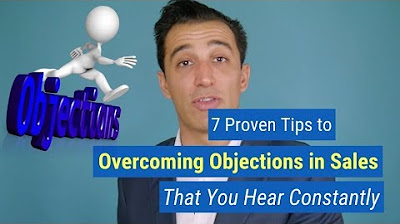How to Sell Your Product or Service - Delivering a Sales Presentation (Part 7 of 11)
Summary
TLDRThis video script emphasizes the importance of thoroughly understanding customer problems and anticipating objections during the sales presentation phase. It advises sales professionals to avoid immediately offering solutions or countering objections and instead to incorporate these insights into their presentation. By addressing customer concerns upfront, especially anticipated objections such as pricing, and aligning the solution with the customer's needs, the salesperson can maintain control of the conversation. The goal is to create a compelling presentation that demonstrates the salesperson’s understanding, leading to a higher likelihood of closing the sale.
Takeaways
- 😀 Ask situational questions to uncover the customer's problems before offering a solution.
- 😀 Avoid jumping into the solution phase too early—wait until you've gathered enough information.
- 😀 The presentation phase begins once you've fully understood the customer's needs and pain points.
- 😀 Incorporate the customer’s specific problems into your presentation, showing how your product or service addresses those issues.
- 😀 Anticipate objections before they are raised by the customer and address them proactively in the presentation.
- 😀 A blocking objection is an objection you raise and address before the customer brings it up, maintaining control of the conversation.
- 😀 For common objections (e.g., pricing), mention them upfront and explain why they exist rather than waiting until the end of the presentation.
- 😀 Preemptively solving problems in your presentation builds trust and positions you as someone who truly understands the customer’s needs.
- 😀 Create a list of customer problems you can solve and potential objections they might raise.
- 😀 Incorporate both the customer’s problems and anticipated objections into the flow of your presentation to demonstrate your preparation and understanding.
- 😀 Addressing anticipated objections during the presentation increases the likelihood that the customer will view you as the right solution provider.
Q & A
What is the primary focus during the presentation phase?
-The primary focus during the presentation phase is to incorporate the problems the customer has mentioned into your presentation while also addressing anticipated objections.
Why should you avoid comparing your product to competitors too early?
-You should resist the temptation to compare your product to competitors too early to maintain control of the conversation and allow the customer to express their needs fully before presenting solutions.
What is a 'blocking objection'?
-A blocking objection is a potential concern the customer might raise, such as pricing, that you proactively address in your presentation to prevent it from becoming a barrier to the sale.
How should you handle pricing objections during a presentation?
-You should address pricing objections upfront by explaining that your prices are typically higher than competitors' and then elaborating on the reasons why this is the case.
What is the benefit of raising objections yourself in a presentation?
-Raising objections yourself shows that you are in tune with the customer’s concerns, helps maintain control of the discussion, and allows you to present solutions confidently.
What should you prepare before your presentation?
-Before your presentation, you should list the problems your customers may have, anticipate objections they might raise, and plan how to address both during your presentation.
Why is it important to understand the customer’s problems?
-Understanding the customer’s problems is crucial as it allows you to tailor your presentation to address their specific needs, making your solution more relevant and compelling.
How can incorporating found problems into your presentation impact customer perception?
-Incorporating found problems into your presentation helps the customer feel understood and demonstrates that you can provide solutions, which can enhance their likelihood of purchasing from you.
What should you do if you consistently encounter the same objections?
-If you consistently encounter the same objections, proactively include them in your presentation, along with your responses, to preemptively address concerns and build trust with the customer.
What is the ultimate goal of preparing for a presentation as outlined in the script?
-The ultimate goal of preparing for a presentation is to create a compelling case that addresses customer problems and objections, ultimately leading to increased trust and a higher chance of closing the sale.
Outlines

This section is available to paid users only. Please upgrade to access this part.
Upgrade NowMindmap

This section is available to paid users only. Please upgrade to access this part.
Upgrade NowKeywords

This section is available to paid users only. Please upgrade to access this part.
Upgrade NowHighlights

This section is available to paid users only. Please upgrade to access this part.
Upgrade NowTranscripts

This section is available to paid users only. Please upgrade to access this part.
Upgrade NowBrowse More Related Video

Diffuse Sales Objections With This Technique

7 (Proven) Tips to Overcoming Objections in Sales That You Hear Constantly [Avoidance]

10x Revenue with 1 New Sales Process... Here's How

Шпаргалка возражений в продажах! / Эффективная техника работы с возражениями

Close The Sale by BLOCKING not Overcoming the Objection - How to Sell

The Secret To Alex Hormozi's Sales Success
5.0 / 5 (0 votes)